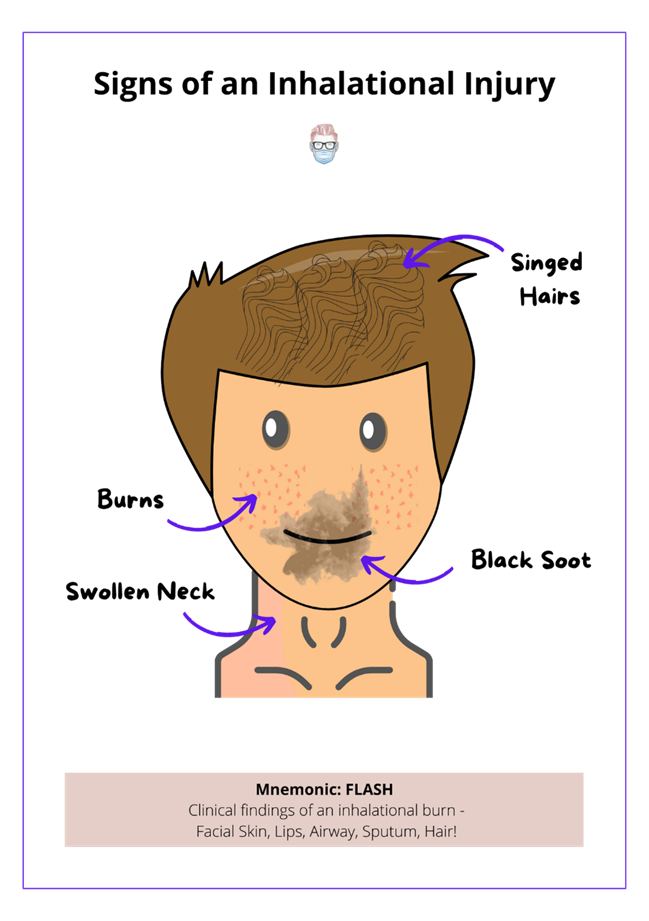A nurse working in an emergency department is performing triage. To which of the following clients should the nurse assign priority?
A client who reports night sweats and fever for the last week
A client who has compound fractures of the tibia and humerus
A client who reports severe vomiting and diarrhea
A client who has soot markings around each naris following a house fire
The Correct Answer is D
a. A client who reports night sweats and fever for the last week:
Night sweats and fever can be indicative of various underlying conditions, including infections. While these symptoms may require medical attention, they do not necessarily indicate an immediately life-threatening condition compared to other options.
b. A client who has compound fractures of the tibia and humerus:
Compound fractures involve broken bones that penetrate through the skin, leading to a risk of severe bleeding, infection, and other complications. This client's injuries are significant and require immediate attention to prevent further complications and provide pain management and stabilization.
c. A client who reports severe vomiting and diarrhea:
Severe vomiting and diarrhea can lead to dehydration, electrolyte imbalances, and other complications, especially if prolonged or accompanied by other symptoms such as fever. While this client requires prompt assessment and treatment, the urgency may not be as high as for other conditions.
d. A client who has soot markings around each naris following a house fire:
Soot markings around the nares (nostrils) suggest inhalation injury, which can lead to airway compromise, respiratory distress, and other serious complications. This client requires immediate assessment and intervention to ensure airway patency, oxygenation, and respiratory support.

Nursing Test Bank
Naxlex Comprehensive Predictor Exams
Related Questions
Correct Answer is D
Explanation
a. A client is refusing care from assistive personnel of the opposite gender:
This situation involves the client's right to refuse care based on personal preferences or cultural beliefs. While it requires attention and respect for the client's wishes, it may not pose an immediate risk to patient care or staff safety.
b. No transport assistance is available to take a client to physical therapy:
This can be resolved by contacting the transportation department or finding an alternative solution, but it is not a critical issue that requires immediate attention.
c. Two nurses had a heated disagreement about a scheduling issue:
While workplace conflicts should be addressed to promote a positive work environment, a heated disagreement about a scheduling issue may not pose an immediate threat to patient care. However, if the disagreement escalates or affects staff morale, it could impact unit functioning and require intervention.
d. Three staff members have called to say they will be absent:
This situation has the most immediate impact on the overall functioning of the unit. Staffing shortages can affect patient care and safety, so it is crucial to address this issue promptly to ensure adequate coverage and maintain the quality of care.
Correct Answer is A
Explanation
a. Contact the case manager to discuss discharge options: This is an appropriate action. The case manager can assist in assessing the client's needs and coordinating appropriate discharge arrangements, such as arranging for home health services or exploring alternative care options.
b. Request another family member assist the client’s partner with care: This may be a helpful action if there is another family member who can provide support. However, it's important to consider the availability and willingness of other family members to take on caregiving responsibilities.
c. Recommend the partner place the client in a long-term care facility: This option may be considered if the partner is unable to continue providing care and there are no other feasible options available. However, it should be discussed with the client and their partner and explored as one of several potential solutions.
d. Ask the provider to delay the client’s discharge home for a few more days: This may be appropriate if there are concerns about the client's safety or if additional time is needed to arrange for alternative care options. However, it's important to address the underlying issues contributing to the partner's inability to provide care and to explore long-term solutions.
Whether you are a student looking to ace your exams or a practicing nurse seeking to enhance your expertise , our nursing education contents will empower you with the confidence and competence to make a difference in the lives of patients and become a respected leader in the healthcare field.
Visit Naxlex, invest in your future and unlock endless possibilities with our unparalleled nursing education contents today
Report Wrong Answer on the Current Question
Do you disagree with the answer? If yes, what is your expected answer? Explain.
Kindly be descriptive with the issue you are facing.
